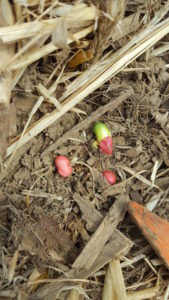Thus far, reports are that thrips populations have been relatively light but picking up. The forecast model (http://climate.ncsu.edu/CottonTIP) has been predicting that cotton planted after May 15th will face the highest infestations of tobacco thrips, and it appears accurate. Having said that, Continue reading
Recent Updates
Managing Large Palmer Amaranth in Large Corn
Judging by our research here as well as field visits and phone calls from folks walking corn fields it is very apparent that pretty much any PRE applied herbicide in corn has given out. Even some of the PRE applied herbicides that traditionally have provided consistently long weed control like Acuron or Bicep have given out about 25 days after application. In a few fields I visited today clearly no PRE was applied to the corn and Palmer amaranth jungles were very evident in the fields. After visiting these fields I will take a PRE that has given out any day. Continue reading
Tennessee Market Highlights
Corn, cotton, and wheat were up; soybeans were down for the week. Trade negotiations and weather continued to drive market direction this week. However, bubbling under the surface of commodity markets is the strengthening USD, which could have an impact on US agricultural exports for the remainder of 2018 and beyond. The USD Index has increased from 89.23 on April 17 to 93.38 on May 17, a 4.6% increase in value in one month. A strong USD makes agricultural exports less competitive on the global market. The USD index is a weighted measure of several currencies, so it provides a general direction of the strength of the USD relative to a global basket of currencies. Each commodity has currency exchange rates that are more important. For example, the Brazilian Real-to-USD exchange rate is important to soybean exports. As of May 17, 2018, one Brazilian Real would purchase 0.26997 USD, down 8.3% in the past month (On April 17, one Brazilian Real would purchase 0.29449 USD). While many factors impact the global demand for soybeans it will be important to watch the strength of the USD relative to the Brazilian Real (and to a lesser extent the Argentina Peso) throughout 2018 and into 2019. Continue reading at Tennessee Market Highlights.
Rain needed for soybean emergence
 The hot, dry weather has sapped surface moisture pretty well in parts of the state, which is affecting ease of planting and soybean emergence. Continue reading
The hot, dry weather has sapped surface moisture pretty well in parts of the state, which is affecting ease of planting and soybean emergence. Continue reading
Destroying a Poor Corn Stand to be Planted Back to Soybean or Cotton
Clearly the most frequent call the last few days of April and the first half of May has concerned corn replant. All through early May the calls have been on how to destroy a partial stand of corn and replant back to corn. In just the last few days the question has been on how to remove a poor stand of corn and then plant back to soybeans or cotton. Continue reading
Tennessee Weekly Crop & Weather Report
WARM AND DRY CONDITIONS PUT PRODUCERS TO WORK
Tennessee farmers made significant progress during 6.0 days suitable for field work. The state experienced warm and dry conditions for most of the week. This allowed producers to make considerable headway with all plantings, fungicide applications, and hay cutting. Many report improved conditions for most crops and cattle due to the favorable weather. Some are concerned with hay yields due to the previously low temperatures, but hopeful for the condition of future cuttings. Topsoil moisture was 1 percent very short, 8 percent short, 84 percent adequate, and 7 percent surplus. Subsoil moisture was 3 percent short, 67 percent adequate, and 30 percent surplus. Continue reading at TN_05_14_18. The U.S. Crop Progress report can be read at CropProg-05-14-2018.
Scout Cotton and Soybean Fields Planted Last Week for Palmer Amaranth
I have gotten numerous reports of Palmer amaranth becoming established in fields where PRE applied herbicides were not activated by timely rainfall. Indeed I have seen some in my research as well. There were many acres of cotton and soybean planted May 7 to May 14. The rain that was in the forecast for last week was a no-show. The result is many of the PRE applied herbicides sprayed on all those cotton and soybean acres was not activated. This has led to a large flush of Palmer amaranth to emerge with the cotton and soybean in a good number of fields in Tennessee. Continue reading

